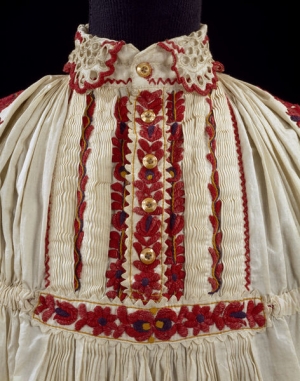From the late eighteenth century, Hungarian embroidery can be divided into two main categories. The first is the work produced by women at home, which centred on the embellishment of men and women’s clothing, as well as the decoration of household items, such as towels and bedding (especially sheets and pillows). By the end of the twentieth century many of these designs were appearing on other items as well, such as wall hangings, table runners, mats, and so forth, small items that appeal to the tourist market (both internal and international).
The second form of embroidery was produced by men for commercial purposes. These craftsmen were normally members of various guilds, including that of the furriers. The products produced by these men included jackets (ködmön) and the larger embroidered coats (suba), both of which were made from sheepskin, and the mantles (szür) made from felt. All of these garments were decorated with embroidered or appliqué panels (felt appliqués on cloth; leather appliqués on leather), or sometimes a combination of appliqué and embroidery.
By the early twentieth century there were numerous forms of Hungarian embroidery based on regional variations, including Beregi; Buzsák (Turkish ornament); Hódmezövásárhely; Kolocsa; Matyo (Mezökövesd, Szentistván and Tard); Matyóföld; Mezökövesd; Sárköz and Transdanubia. It should be noted that there were many variations within a single region. Hungary is also believed by various authors to be the place where Florentine work originated, perhaps among groups of Florentine craftsmen who settled in Hungary in the fifteenth century.
As is happening in many parts of the world, many of the modern examples of embroidery on sale in Hungary and via the internet are actually made in China for the Hungarian market. These pieces should be regarded as in the Hungarian style.
Source: FÉL, Edit (1961). Hungarian Peasant Embroidery, London: B.T. Batsford.
V&A online catalogue (retrieved 6 July 2016).
GVE

